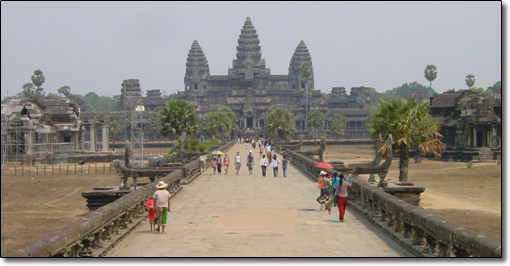
Angkor Wat
Spreading out over the flat countryside around Siem Reap, Angkor Wat occupies an immense area. Its scale puts modern sites to shame. That the stone ruins represent only a fraction of the original heart of the Khmer empire, where only thick forest grows today, is beyond imagination. We tried to keep this in mind as we pedaled the eight kilometers from Siem Reap to the Angkor Wat entrance in the blazing heat. From there it was another few kilometers to the next major site, the Bayon, passing through a gate with giant carved heads facing the four cardinal directions. On our first day we made a giant loop around the major sites, covering more than 35 km. There is Preah Khan, the temple of the sacred sword, with strangler figs growing over the stone ruins and the stone outline of a two-storied library. Further out is an empty pool with giant cobra statues. The architecture at Angkor Wat is surprisingly homogenous. The Khmers built everything in the same style, even as far away as Isan or their embassy in Sukhothai, an ancient Thai capital.
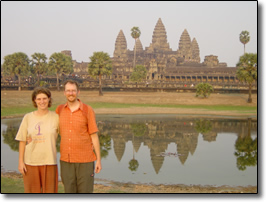 |
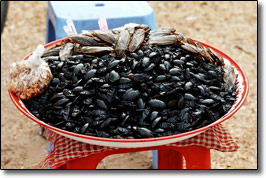 |
Unwary tourists can easily get “templed-out” by going too fast. Our seven-day pass gave us enough time to see what we wanted at our own pace, with time to return to our favorite sites as we liked. Unless you arrive very early in the morning or very late in the evening it is very hard to be alone in the sites. Busloads of tourists, mostly Asians, crowd the popular attractions. Gaggles of noisy, sneaker-clad tourists make it difficult to appreciate the exquisite carvings and bas-reliefs. Many of the groups stay only 15-20 minutes at each site in order to “see” the entire Angkor Wat archeological park in a day. Luckily at midday most of the tourists return to Siem Reap for lunch, leaving us to lounge in the cool stone hallways and wander the ruins at leisure. With the searing heat we had to move slowly, take long breaks and stay out of the sun. Drinking the juice from a fresh green coconut was a special, cooling treat. In front of every temple is a row of restaurants - with so much competition we could bargain down the high printed menu prices for a meal with a view. We would arrive, deposit our water bottle in their cooler, see the temple and return for a cold drink with our lunch.
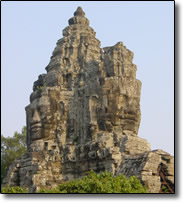 |
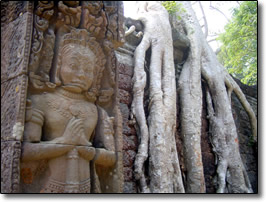 |
The temple of Angkor Wat itself is remarkable. Surrounded by a moat and a wall of immense proportions, the temple somehow manages to impress with its height as well as its breadth. As you cross the bridge and walk through the main gate, the towers of the complex loom in the distance. Your heart jumps - the dream of a lifetime has become reality. Angkor Wat looks stunning from every viewpoint. As you walk down the long path that leads to the temple, you have time to admire the harmony and coherence of the ensemble. The sides spread out to the limit of vision while the bowed towers rise above and dominate the whole, a triumph of vertical and horizontal proportions. Reflecting pools are laid out to exploit the changing views during the long approach. Around the outer wall of the temple are long bas-relief panels depicting scenes from the Indian myths that were adapted by the Khmer god-kings to justify their absolute power. There are vast battles, glory and carnage as warring armies face each other with elephants, horses and soldiers across the polished stone, letting fly swarms of arrows among forests of lances. The detail is so rich one can almost hear the cries of victory and desperation in the ruckus and turmoil of battle. Around the back wall is a relief of the churning of the ocean of milk, an Indian creation-myth, where Vishnu, incarnated as a turtle, supports a vast pivot, churned with the aid of a coiled serpent pulled in a colossal tug-of-war by armies of gods and demons. Representations of this myth can be seen elsewhere at Angkor Wat: balustrades are composed of rows of gods or demons grasping the serpent's body, its hooded, seven-faced head staring at oncoming visitors. Once through the outer porch of Angkor, steep stairways climb to the inner courtyard, where thousands of heavenly apsara dancers decorate the square stone pillars. Each dancer is different. After climbing to the penultimate level, at the base of the main tower, it is hard not to feel vertigo when looking down on the lower roofs and courtyards below. The steps are as steep as any Mayan pyramid, easy to climb but precarious to descend.
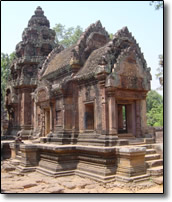 |
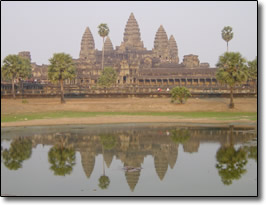 |
